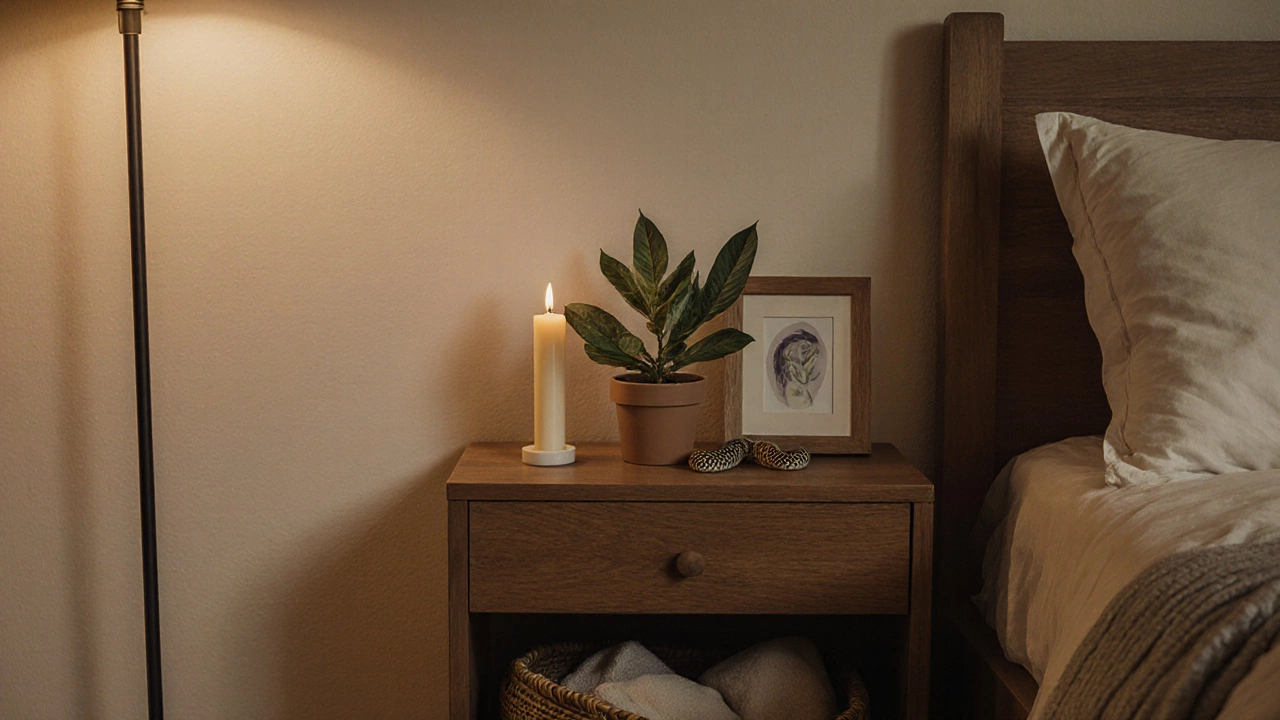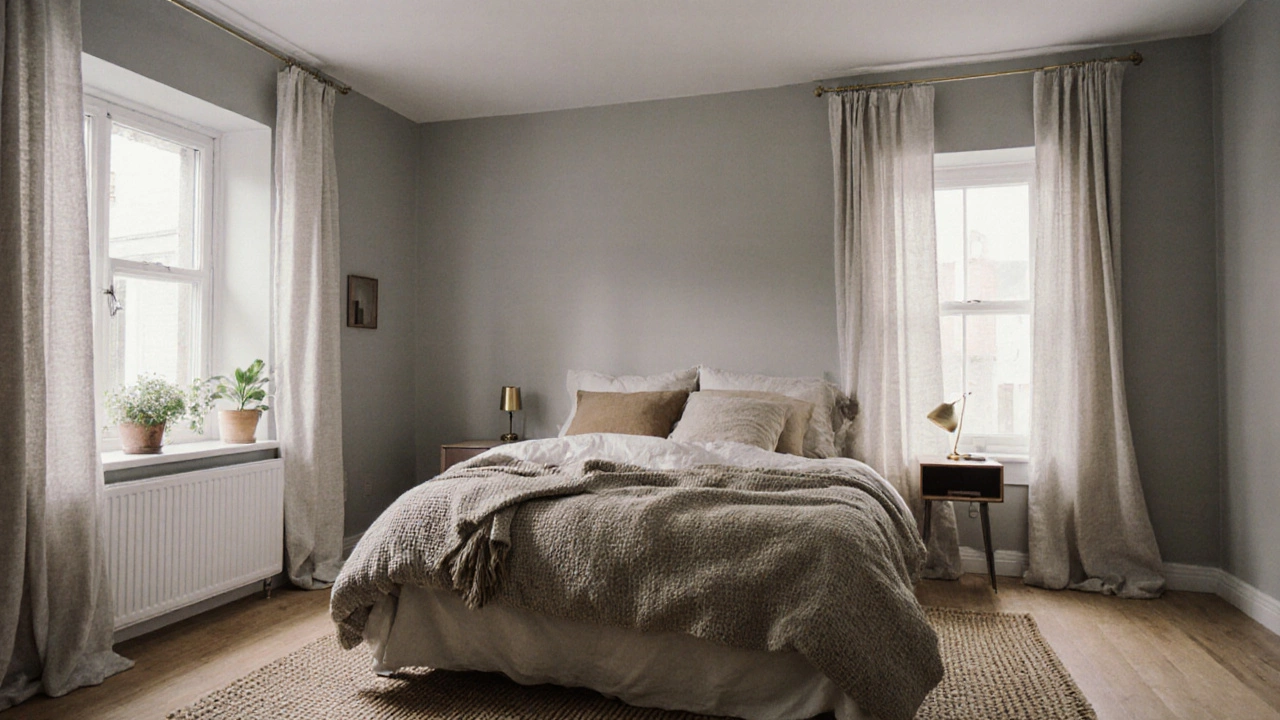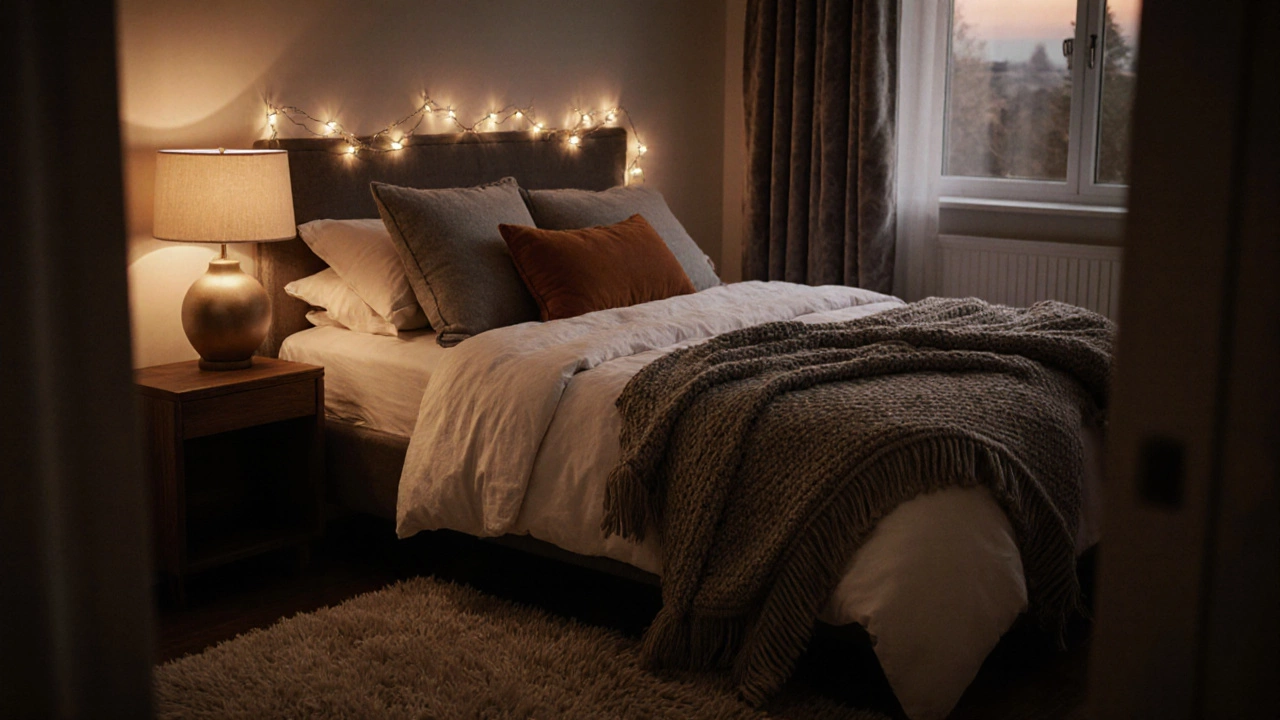Cozy Bedroom Checklist Calculator
Your Cozy Bedroom Assessment
Check off the elements from the article to see your progress toward a truly cozy bedroom.
Your Cozy Assessment
Your bedroom currently has 0% of the essential cozy elements. Keep going—small changes make a big difference!
There’s something about a cozy bedroom that makes you want to crawl under the blankets and never leave. But if your room feels cold, sterile, or just plain boring, it’s not because you lack taste-it’s because the little things are missing. You don’t need a full renovation or a designer budget. Making your bedroom feel warm and inviting is about layering texture, softening light, and choosing things that feel good to touch.
Start with the bed-it’s the heart of the room
Your bed should feel like a hug. That means going beyond just a flat sheet. Layer a fitted sheet, a flat sheet, a soft quilt or duvet, and at least two plush pillows. Add a throw blanket draped casually at the foot. The key is volume and texture. Linen looks nice, but cotton flannel or a knit wool blanket? That’s where the coziness lives. Choose colors that feel warm: cream, soft gray, muted terracotta, or even a deep navy. Avoid white bedding unless it’s layered with something textured. A white duvet on a white floor with white walls? That’s a hospital, not a sanctuary.
Invest in a good mattress topper if your bed feels too firm. Memory foam or down alternative toppers make a huge difference in comfort. And don’t forget the pillows-plump ones under your head, and thinner ones behind your back when you’re reading in bed. People forget: pillows aren’t just for sleeping. They’re for lounging, reading, scrolling, and just being.
Lighting is everything
Overhead lights are the enemy of coziness. They’re harsh, flat, and make your room feel like a warehouse. Instead, use multiple light sources at different levels. A bedside lamp with a fabric shade casts a warm glow. A floor lamp in the corner adds depth. String lights around a headboard or along the ceiling? They’re not just for dorm rooms-they’re magic in a bedroom. LED fairy lights use almost no power and create a soft, dreamy haze.
Look for bulbs labeled 2700K or lower. That’s the warm white range. Anything higher than 3000K starts to feel clinical. If you have dimmers, use them. Even a simple plug-in dimmer switch for your lamp can transform the mood. At night, turn off the main light. Let just one or two lamps glow. That’s when the room starts to feel alive.
Add texture, not just stuff
Texture is what turns a room from “nice” to “I never want to leave.” Start with rugs. A thick, shaggy rug under the bed or beside it makes a huge difference. Wool, jute, or a blend with some synthetic fibers for durability works best. Avoid thin, plastic-looking rugs-they reflect light and feel cold underfoot.
Curtains matter more than people think. Heavy, floor-length curtains in velvet, linen, or cotton blackout fabric do two things: they block outside light for better sleep and they soften the room visually. If your windows are bare, the room feels empty. If they’re draped, it feels wrapped in warmth.
Throw pillows on a chair, a bench, or even on the floor next to the bed? Yes. Mix sizes and fabrics-a knitted pillow next to a velvet one, a linen pillow with a tassel. Don’t overdo it-three to five is enough. Too many looks messy. Too few looks empty.

Bring in nature, but keep it simple
Plants don’t have to be big. A single snake plant on a nightstand, a small potted eucalyptus on the dresser, or a hanging pothos near the window adds life without clutter. They clean the air, reduce stress, and make the space feel cared for. If you don’t have a green thumb, go for faux plants made with real-looking materials. High-quality silk or plastic ones can look just as good, especially if they’re dusted regularly.
Wood brings warmth too. A wooden nightstand, a carved bench at the foot of the bed, or even a simple wooden tray on your dresser adds grounding. Avoid glossy, modern finishes. Look for matte, hand-rubbed, or reclaimed wood. It has character. Metal and glass? Use sparingly. They reflect light and feel cold. Save them for small accents, like a single brass lamp or a glass vase.
Declutter like you’re preparing for a nap
A cozy room isn’t a cluttered room. It’s a calm one. If your floor is covered in clothes, your nightstand is piled with random stuff, or your closet door won’t shut? That’s the opposite of cozy. Start by removing anything that doesn’t belong. Clothes go in the closet. Books go on a shelf. Chargers go in a drawer. Use baskets or bins to hide the mess. A woven basket under the bed for extra blankets? Perfect. A pile of laundry on the chair? That’s not cozy-it’s stress.
Keep surfaces clear. One candle, one small photo, one book. That’s it. Less is more when you’re going for calm. The goal isn’t to fill every inch-it’s to leave space for breathing, both physically and mentally.
Smell and sound complete the experience
You don’t see scent or sound, but you feel them. A warm candle with notes of vanilla, sandalwood, or lavender can turn your room into a spa. Use beeswax or soy candles-they burn cleaner and smell better than paraffin. Light it for 30 minutes before bed. Turn it off before you sleep. Or use an essential oil diffuser with a timer.
Sound matters too. A small Bluetooth speaker playing ambient noise-rain, fireplace crackles, or soft jazz-can make the room feel alive without being loud. White noise machines work too. If your room is too quiet, it can feel empty. If it’s too noisy, it feels chaotic. Find the middle ground.

Personal touches make it yours
Cozy doesn’t mean generic. It means personal. Hang one or two photos you love-not framed in sterile black, but in simple wooden frames or pinned to a string with clothespins. Display a favorite book you’ve read and want to reread. Put out a small bowl of smooth stones or a scented soap you enjoy using. These aren’t decorations. They’re reminders of comfort.
And don’t forget the little things: a soft robe hanging on the back of the door, slippers by the bed, a hot water bottle tucked under the covers on cold nights. These aren’t luxuries. They’re rituals. And rituals turn a bedroom into a refuge.
What doesn’t work
Don’t buy a “cozy” set from a big-box store that looks like it came from a catalog. If it doesn’t feel good to touch, it won’t feel cozy. Don’t overdo patterns. One patterned pillow or one textured rug is enough. Too many prints make the room feel busy, not calm.
Don’t use bright colors unless they’re muted. Neon yellow, electric blue, or bold reds don’t belong in a bedroom meant for rest. Stick to earth tones, neutrals, and soft pastels. And don’t ignore the ceiling. Paint it the same color as the walls, or a shade lighter. A white ceiling can make the room feel taller, but it also feels cold. A soft cream or pale gray ceiling makes the space feel wrapped in warmth.
Final checklist: Your cozy bedroom in 5 steps
- Layer your bed with at least three textures: sheet, duvet, throw blanket.
- Replace overhead lighting with three soft light sources: bedside lamp, floor lamp, string lights.
- Add a thick rug under the bed or beside it.
- Hang heavy curtains and keep surfaces clear-only one or two personal items.
- Light a candle or run a diffuser with a calming scent for 30 minutes before bed.
That’s it. No expensive purchases. No redesign. Just small, thoughtful changes that add up. Your bedroom should feel like the place you come back to-not just to sleep, but to rest, to breathe, to be still. And that’s what cozy really means.
What colors make a bedroom look cozy?
Warm neutrals like cream, soft gray, muted taupe, and warm white create a calm base. Add depth with earth tones like terracotta, olive green, or deep navy. Avoid cool grays, bright whites, or stark black. These feel cold or harsh. Paint the ceiling a shade lighter than the walls to keep the space feeling enclosed and warm.
Do I need a rug to make my bedroom cozy?
Not absolutely, but it makes a huge difference. A thick, soft rug under the bed or beside it adds warmth underfoot and softens the room’s acoustics. Wool, jute, or a wool-blend rug works best. Avoid thin, synthetic rugs-they reflect light and feel cheap. Even a small 3x5 rug helps if you can’t fit a full-size one.
Can I make a small bedroom look cozy?
Yes, and sometimes it’s easier. Use light colors on walls to make the space feel bigger. Add layered lighting so you don’t rely on one harsh overhead bulb. Use mirrors to reflect light and create depth. Keep clutter to a minimum. A small room with texture, warmth, and calm feels more inviting than a large one filled with stuff.
How do I choose the right bedding for coziness?
Look for high thread count cotton (300-600), flannel, or linen blends. Avoid polyester-it traps heat and feels synthetic. Layer a fitted sheet, flat sheet, duvet, and a throw blanket. Pillows should be plump and supportive. Use different textures: smooth cotton next to a knitted or velvet pillow. Wash your bedding weekly-it keeps it feeling fresh and inviting.
Are candles safe to use in the bedroom?
Yes, if you use them wisely. Choose soy or beeswax candles-they burn cleanly and slowly. Never leave them unattended. Place them on heat-resistant surfaces away from curtains or bedding. Use a timer or turn them off before falling asleep. Electric candles or LED alternatives are safe if you want the look without the flame.


